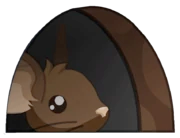
Coats, Markings, + Traits
Coat Types


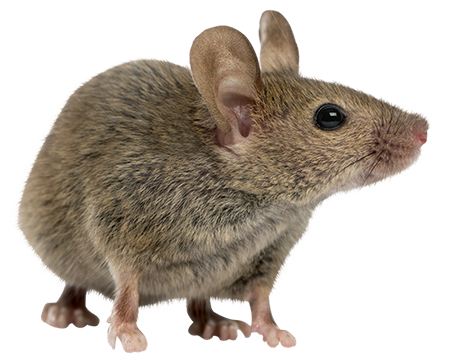 Standard / Shorthair / Wild Type
Standard / Shorthair / Wild TypeShorthair is the common mouse coat type, having originated in the wild.
Shorthair is dominant.


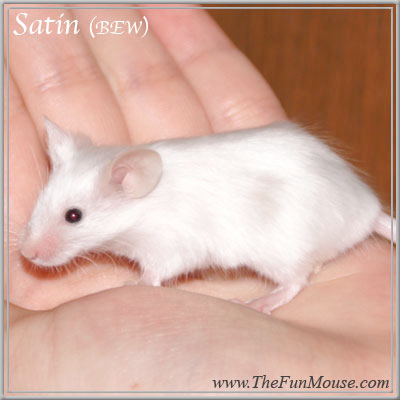 Satin
SatinThe second most common kind of coat among pet shop mice, satin coats are short-haired and shiny with a silky texture. It can be harder to see on dark-colored mice.
Satin is recessive and occurs in genotype sa/sa on chromosome 13. It first originated in laboratory settings as a radiation-induced mutation.


 Angora
AngoraAngora is like satin but long-haired. Reportedly, their fur feels like wool.
Angora is recessive and occurs in genotype go/go on chromosome 5. It first originated in laboratory settings as a result of genetic deletion.


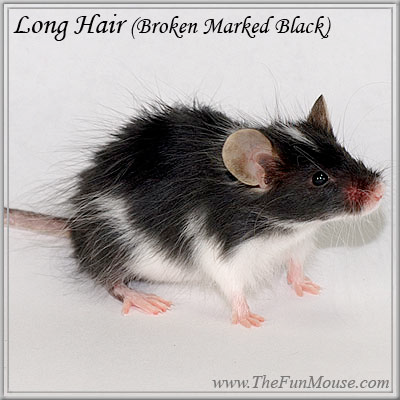 Long Hair
Long HairLong hair mice, as the name implies, have long hair.
Long hair is recessive and occurs in genotype lgh/lgh on chromosome 8. It first originated as a result of random mutation.


 Astrex / Rex
Astrex / RexRex mice have short, curly hair.
Rex is dominant and occurs in genotype Re/* on chromosome 11. It first originated as a result of random mutation in commerical breeding.
Not to be confused with Caracul / Keratin 71, which is also dominant (Ca/*) and occurs on chromosome 15. Caracul mice usually have wavy coats and curled whiskers, and their curled coats tend to straighten out at 4 weeks old, resulting in adults having weaker curls or no curls at all. Inside, they look "plushy". Caraculs have a distinct "kink" at the tips of their hairs.
Caracul-like (Cal/*), a mutation of Caracul, also exists, but the curls straighten out at 8 weeks old.
Caracul-like has 6 mutations, Caracul-like 2 through 7 (Cal2/* - Cal7/*). Caracul-like 2 through 6 tend to vary how long the mouse keeps their curls, but Caracurl-like 7 lightens the overall color of the mouse, eyes and skin included.


 Texel
TexelTexels have long, curly hair.
Texel is a combination gene. Normally it occurs when Rex and Angora are combined, but can also occur when Rex, Caracul, or Frizzy are combined with Angora or Long Hair.


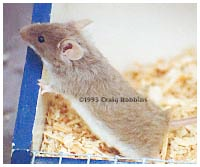 Frizzie / Frizzy
Frizzie / FrizzyFrizzies have short, crimped fur, and some have slight curl. Visually, they may be hard to tell apart from Shorthairs, but difference is noticeable when touched.
Frizzy is recessive and occurs in genotype fr/fr on chromosome 7. It first originated as a result of random mutation in a laboratory setting.
Frizzy-like (frzl/frzl) also exists, and according to PMF, is visually similar to Rex, but I can't find any photos or non-PMF info on this coat type.


 Fuzzy / Fuzzy Hairless / Frizzled
Fuzzy / Fuzzy Hairless / FrizzledFuzzy mice have short, tightly-curled coats that resemble the soft side of velcro. They range from completely hairless to densely coated.
Fuzzy is recessive and occurs in genotype fz/fz on chromosome 1. It first originated as a result of random mutation in commercial breeding.


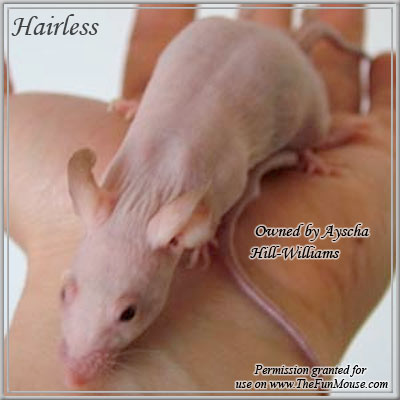 Hairless
HairlessHairless mice have very, very little fur and appear furless. What fur they do have is translucent.
Hairless is recessive and occurs in genotype hr/hr on chromosome 14. It first originated as a result of retroviral integration, or when a retrovirus takes over a healthy cell and copies its genome over to the host DNA.
Not to be confused with Nude (nu/nu) on chromosome 11. Nude mice never grow hair to begin with and normally die by weaning age.


 Rhino Hairless / Rhino
Rhino Hairless / RhinoRhino mice are heavily wrinkled, so much their wrinkles are said to look like a rhino's armor.
Rhino is recessive and occurs in genotype hrrh/hrrh on chromosome 14. It first originated as a result of the random mutation of Hairless.


 Rosette / Abyssinian
Rosette / AbyssinianRosette mice have hair that runs in the opposite direction than normal. Normally, this shows as a "rosette", or a whorl of fur, normally located on the hips, or as back ridges.
Rosette is recessive and occurs in genotype rst/rst. It first originated as a result of random mutation in commericial breeding.
Self Colors


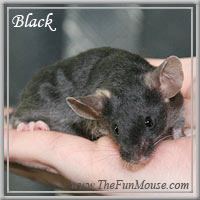 Black
BlackBlack mice are very dark mice that aren't blatantly brown at first glance. They may have patches of dark skin and a dark gradient in the ears, but they are light-skinned otherwise. When they're babies, they'll have yellow hairs around their ears, genitals, and base of the tail, and they lose these when their adult coat comes in.
Black is recessive and occurs in genotype a/a on chromosome 2. It first originated as a result of random mutation, but it can also be induced by radiation and chemical induction.


 Extreme Black
Extreme BlackExtreme black mice are extremely darkly-colored mice, even their skin is dark. They don't have the same brown/red in their coat that black mice do, and they lack the yellow hairs that black mice do.
Extreme black is recessive and is a mutation of Black. It occurs in genotype ae/ae on chromosome 2. It first originated as a result of radiation-induced mutation.


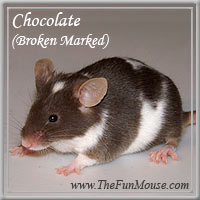 Chocolate / Brown
Chocolate / BrownChocolate mice are brown mice who range from being similar in color to milk chocolate all the way to very dark chocolate.
Chocolate is recessive and occurs in genotype b/b on chromosome 4. Its origins vary on strain.
Chocolate is black-based and thus only occurs in mice with black or extreme black. "Extreme chocolate" (ae/ae b/b) is the extreme black variant of chocolate and results in darker browns with mostly dark skin.
Not to be confused with mock chocolate (cch/ce), which is visually indistingushable from chocolate, but occurs in the C locus and is a combination gene of chinchilla (cch) and extreme dilution (ce).


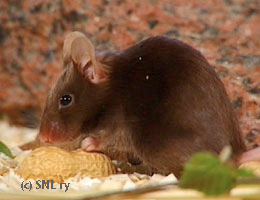 Cordovan
CordovanCordovan mice are reddish-brown mice.
Cordovan is recessive and occurs in genotype bc/bc and bc/b on chromosome 4. It first originated as a result of random mutation.
Cordovan is black-based and thus only occurs in mice with black or extreme black.


 Light Mock Chocolate
Light Mock ChocolateLight mock chocolate mice are pale brown mice, but distingushed from coffee and champange by generally being darker and being caused by a different genotype.
Light mock chocolate is recessive and occurs in genotype cch/c (note the difference between it and standard mock chocolate, which has extreme dilution).
Light mock chocolate is black-based and thus only occurs in mice with black or extreme black.


 Havana
HavanaHavana mice are black with a reddish tint.
Havana is recessive and occurs in genotype cch/cch.
Havana is black-based and thus only occurs in mice with black or extreme black. Havana Tans can't exist due to gene incompatibility.


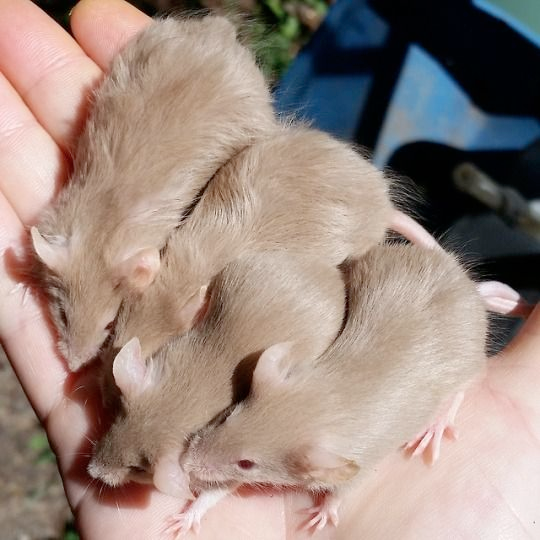 Champange
ChampangeChampange mice are a very, very light brown color that may come with a little pink or yellow tint and have pink/red eyes. Black-eyed champanges are most likely just mislabelled coffees or light mock chocolates, as the colors are difficult to distingush visually, but they appear to exist.
Champange is (usually) a combination gene between Chocolate (b) and Pink Eye Dilution (p).
Champange is black-based and thus only occurs in mice with black or extreme black. Unlike other brown dilutes, however, it doesn't involve the C locus at all.


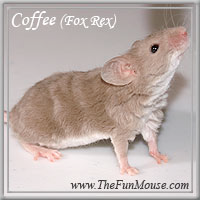 Coffee / Extreme Dilution + Beige / Extreme Dilution
Coffee / Extreme Dilution + Beige / Extreme DilutionCoffee mice are a very, very light brown color.
Coffee is recessive and occurs in genotype ce/ce on chromosome 7. It first originated as a result of random mutation in the wild.
Coffee is black-based and thus only occurs in mice with black or extreme black.
Beige is the same gene as coffee, but it is much, much paler in color. Beige mice are off-white, tan-ish mice.


 Lilac
LilacLilacs are a very light blue-gray color with a pink tint and pink/red eyes. Some may be mistaken for Silvers.
Lilac is a combination gene between black (a) and pink eye dilute (p).
Not to be confused with Dove, also called Lilac in the UK, which is a different gene.


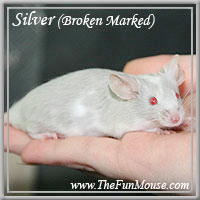 Silver
SilverSilver mice are a very light silver-gray color with pink eyes. Some may be mistaken for Lilacs.
Silver is combination gene between blue dilute (d) and pink eye dilute (p).
Silver is black and blue-based and thus only occurs in mice with black/extreme black and blue dilute.


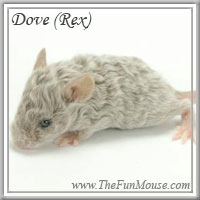 Dove
DoveDoves are a very light blue-gray color. They differ from Lilacs as they have dark eyes and involve blue dilute.
Dove is combination gene between blue dilute (d) and chocolate (b).
Dove is black and blue-based and thus only occurs in mice with black/extreme black and blue dilute.
Not to be confused with Lilac, also called Dove in the UK, which is a different gene.


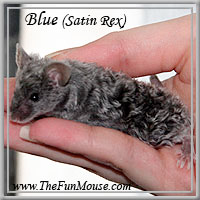 Blue Dilute
Blue DiluteBlue dilutes are darker slate blue-gray mice.
Blue dilute is recessive and occurs in genotype d/d on chromosome 9. It first originated as a result of retroviral integration, or when a retrovirus takes over a healthy cell and copies its genome over to the host DNA.
Blue dilute is black-based and thus only occurs in mice with black or extreme black.


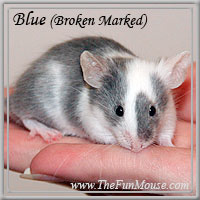 Leaden
LeadenLeadens are usually lighter slate blue-gray mice. They may appear to be as dark as blue dilutes when not combined with other genes.
Leaden is recessive and occurs in genotype ln/ln on chromosome 1. It first originated as a result of random mutation.
Leaden is black-based and thus only occurs in mice with black or extreme black.


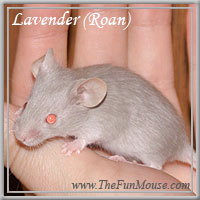 Lavender
LavenderLavenders are pale blue-gray and silver mice with pink tints.
Lavender is a combination between champange (b/b p/p) and silver (d/d p/p).
Lavender is black and blue-based and thus only occurs in mice with black/extreme black and blue dilute


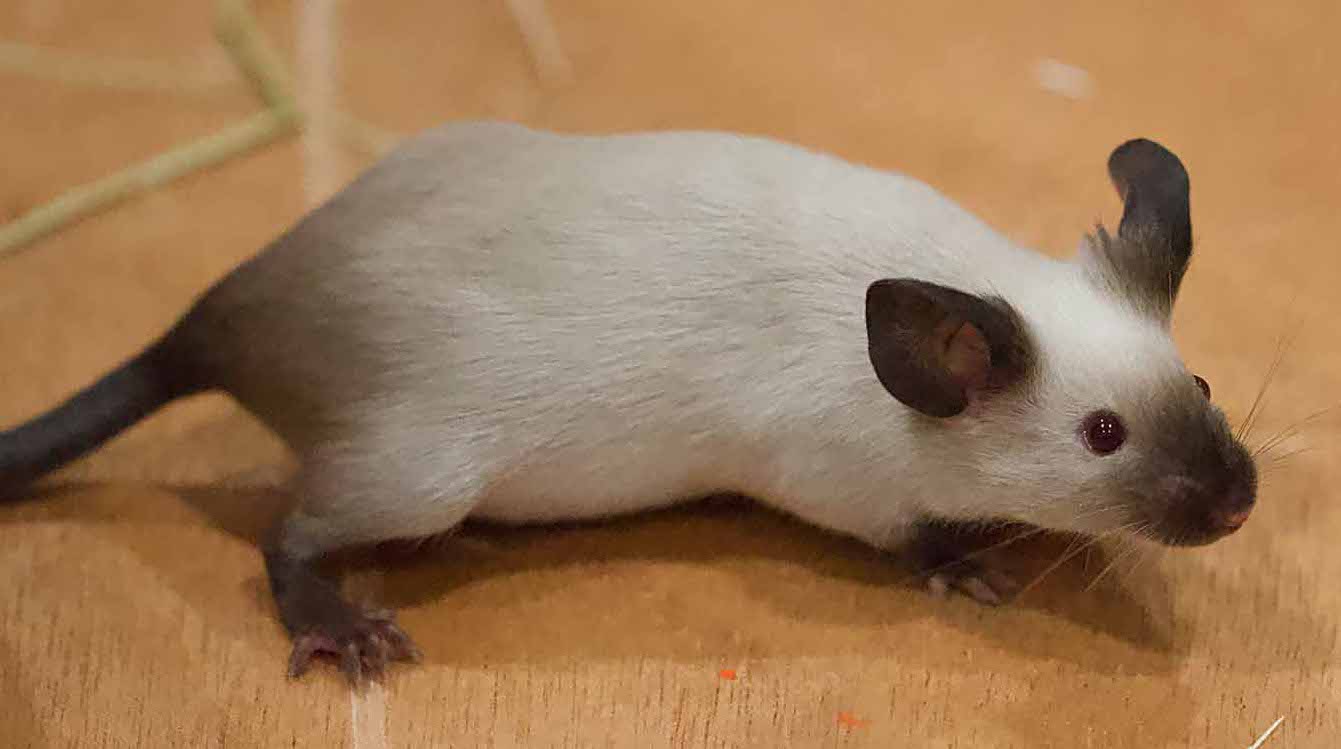 Siamese / Homozygous Himalayan
Siamese / Homozygous HimalayanSiamese mice range from off-white cream to white with dark points that range from light chocolate to black. Like other siamese-patterened animals, the darkest of the points varies on temperature, and is darker in colder months. Their eyes range from ruby to black.
Siamese is recessive and occurs in genotype ch/ch on chromosome 7. It first originated as a result of random mutation.
Siamese is black-based and thus only occurs in mice with black or extreme black.
Not to be mistaken with other himalayan coat types.
Heterozygous Himalayan, or just Himalayan, also exists, and occurs when the genotype is heterozygous with albino (ch/c). The fur is pure white, eyes are pink/red, and the points are usually lighter in color.


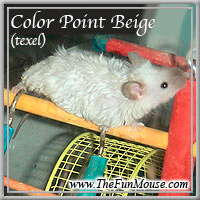 Color Point Biege
Color Point BiegeCPBs are visually similar to siamese but have a pale biege color instead of off-white cream. Generally their points are paler too. Their eyes are dark.
CPB is recessive and occurs in genotype ce/ch.
CPB is black-based and thus only occurs in mice with black or extreme black.
Not to be mistaken with other himalayan coat types.


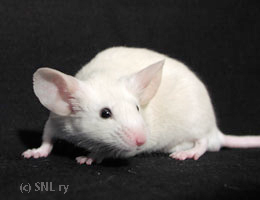 Bone
BoneBone mice are off-white cream-gray in color with dark eyes.
Bone is recessive and occurs in genotype ce/c.
Bone is black-based and thus only occurs in mice with black or extreme black.


 Recessive Yellow
Recessive YellowRecessive yellows are nearly identical to the lethal yellow shades and vary heavily. Normally dark-eyed recessive yellows are lighter in color than red/pink-eyed ones. Unlike lethal yellows, recessive yellow will reduce spotting (if it has spotting) and generally babies are black-ticked and have uneven/sooty coloring. Recessive yellows are also less health issue-prone than lethal yellows.
Recessive yellow is recessive (wow) and occurs in genotype e/e on chromosome 8. It first originated as a result of random frameshift mutation caused by the deletion of a nucleotide in the DNA sequence.
Recessive yellow is black-based and thus only occurs in mice with black or extreme black.


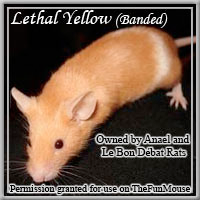 Fawn + Ginger
Fawn + GingerFawn and ginger are the most common lethal yellow colors. They are bright, rich orange colors. The sole difference is that ginger has pink/red eyes (p/p) and fawn does not.
Fawn and ginger are dominant and occur in genotype Ay/a on chromosome 2. It first originated as a result of random mutation in non-commercial breeding.
Fawn and ginger are lethal yellow colors, so homozygeous (Ay/Ay) babies get reabsorbed before birth. Lethal yellow mice are illness-prone, especially to diabetes and/or obesity.


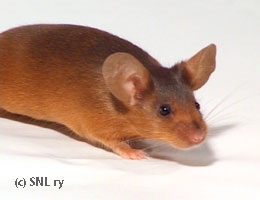 Sable
SableSable mice are rich, golden mice with backs that fade to shiny brown. Their belly may or may not be tan.
Sable is a combination between lethal yellow (Ay), tan belly (at), and Umbrous (U). Non-tan belly sables also exist. It first originated as a result of random mutation in commercial breeding.
Sable is a lethal yellow color, so homozygeous (Ay/Ay) babies get reabsorbed before birth. Lethal yellow mice are illness-prone, especially to diabetes and/or obesity.
Sable has variants that depend on the mouse's brown, white, and blue dilutions.
Silver sable, marten sable, or cream sable combines sable with chinchilla (cch/cch) or extreme dilution (ce/ce) to create mice that range from sepia to gray with yellow hints. Some consider cream sable to be a different coloration and that silver sable doesn't involve chinchilla or extreme dilution at all (depends who you ask), but it's really variable.
Blue sable combines sable with blue (d/d) and/or leaden (ln/ln) to create mice that appear similar to sables, but with bluish backs instead of brown ones.
Lilac sable combines sable with any cordovan (bc/*) and blue (d/d) to create mice with a back similar in color to a reddish version of the lavender.


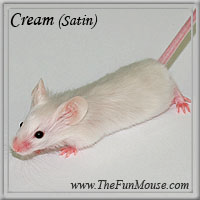 Cream
CreamCream is an off-white, pale yellow color. Most have black eyes, and pink/red-eyed true creams are hard to come by.
Cream is a combination and there are several ways to make it, but the most popular method is via combining lethal yellow (Ay/*) and chinchilla (cch/cch).
Cream is a lethal yellow color, so homozygeous (Ay/Ay) babies get reabsorbed before birth. Lethal yellow mice are illness-prone, especially to diabetes and/or obesity.


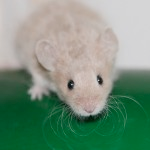 Straw
StrawStraw is usually a pale yellow-brown color often with silver tints or ticking (though in show this is considered a fault). Straw can range from very pale to golden. Straw is difficult to come across, and is more often seen in the base color of blue agoutis.
Straw is a combination between lethal yellow (Ay*) and blue (d/d) or leaden (ln/ln).
Straw is a lethal yellow color, so homozygeous (Ay/Ay) babies get reabsorbed before birth. Lethal yellow mice are illness-prone, especially to diabetes and/or obesity.


 Agouti / Wild Type
Agouti / Wild TypeAgouti is the most common mouse color. Though vibrancy of their reddish-brown tones can vary, agoutis are normally chestnut brown with dark slate blue undercoats. Agoutis notably have black ticking.
Agouti is dominant and occurs in genotype A/* on chromosome 2. It is the natural color of mice.
Agouti has multiple variants. Among the ones not listed below are bone agouti, which adds extreme dilution and albino (ce/c), and silver agouti, which adds chinchilla (cch/cch).


 Cinnamon / Golden Agouti
Cinnamon / Golden AgoutiCinnamon mice range from pale golden brown to vibrant golden tan in color. They have chocolate ticking.
Cinnamon is a combination between agouti (A/*) and chocolate (b/b) or any cordovan (bc/*).


 Apricot
ApricotApricots are light orange, apricot-colored mice. They have pink tinting and their ticking is champange-colored.
Apricot is a combination, and there are two vareties depending on who you ask the definition of "apricot" from.
One apricot is an agouti, made via combining agouti (A/*), chocolate (b/b), and pink eye dilution (p/p).
The other is a lethal yellow, made via combining lethal yellow (Ay/*), brown (b/b), chinchilla (cch/cch), and pink eye dilution (p/p). The mouse pictured to the right is this variant.


 Blue Agouti / Opal
Blue Agouti / OpalBlue agoutis range from dark, steel blue to almost as orange as straw. These mice have straw base color with variable levels of blue ticking, though the heavier this ticking, the more favored it is in show. The tips of the fur are black.
Blue agouti is a combination of agouti (A/*) and blue dilute (d/d).


 Argente
ArgenteArgente mice range from a slightly dull orange to brighter and warmer oranges dependent on how much lilac is present in their coats. They have lilac undercoats and ticking.
Argente is a combination of agouti (A/*) and pink eye dilution (p/p).
Argente has a few variations, notably blue argente or silver argente, which adds the blue dilution (d/d), and cream argente, which adds chinchilla (cch/cch).


 Chinchilla
ChinchillaChinchilla mice get their name from being similar in coloration to chinchillas. These mice have a blue base color with gray middles and black tips. Shows prefer if their belly is white.
Chinchilla comes in two variations. Standard agouti chinchilla (A/* cch/cch) is among the easiest to breed, but shows prefer if their belly is white, which is where the tan-belly chinchilla (A/at cch/cch) and white-bellied agouti chinchilla (Aw/* cch/cch) variants come in. Chinchilla dilutes tan belly to fox.
Chinchilla is recessive and occurs in genotype cch/cch on chromosome 7. It first originated as a result of random mutation in non-commercial breeding.

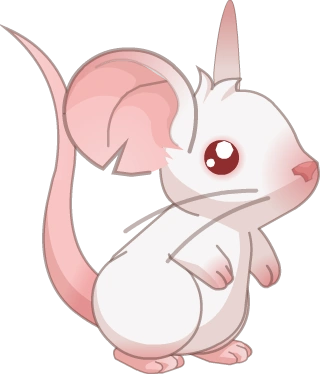
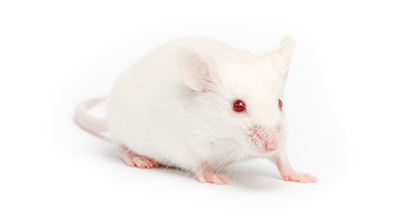 Albino
AlbinoAlbino mice are your standard, common pure white mice with pale pink skin and pink/red eyes.
All mice likely have albino somewhere in their bloodline, due to the massive amounts of inbreeding in the house mouse species, both natural and human-induced.
Albino is recessive and occurs in genotype c/c on chromosome 7. It first originated as a result of random mutation, dating all the way back to the Greeks and Romans.
Like all albino creatures, albino mice are extra sensitive to sunlight and may have vision issues.
Not be mistaken for PEWs, which are mice who simply have the pink eye dilute (p/p) but otherwise normal pigmentation.

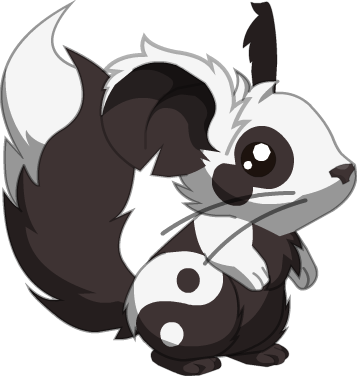
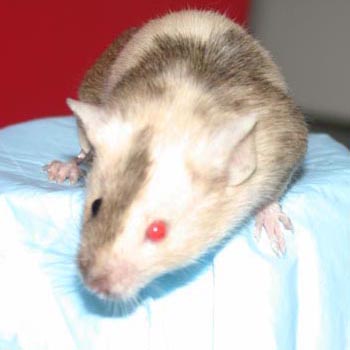 Chimera
ChimeraChimera mice occur when two zygotes fuse into one. This can result in a fusion of colors and patterns. Chimeras can be created in a lab, but in breeding, most chimeras are accidental.
Eye Color


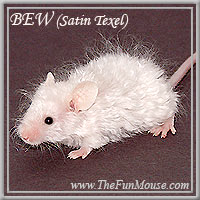 Black + Dark
Black + DarkBlack and dark eyes are common and easy to breed.
White mice with dark eyes are uncommon in pet store feeder stock, as they're mistaken for pure albinos easily. In reality, they're most likely bones (ce/c) due to how common albino is in feeder stocks.
Black is dominant and is the natural eye color of mice. Dark generally occurs when a coat color gene (such as bone) dilutes the eyes to a dark brown color.


 Pink / Red
Pink / RedPink eyes are the common eye color of albinos and pink-eyed whites (PEWs).
Pink-eyed whites are common in pet store feeder stock, as they're mistaken for pure albinos easily. In reality, they're most likely bones (ce/c) with pink eye dilute (p/p) due to how common albino is in feeder stocks. One way to tell the difference is to see if the skin has any pigmentation (see next paragraph).
Pink eyes may come about from pink eye dilute (p/p) or albino (c/c). Pink eye dilute results in PEWs, whereas albino always makes the eyes pink/red. Pink eye dilute also dilutes the pigmentation of mice, but doesn't necessarily get rid of it 100% the way albino does.


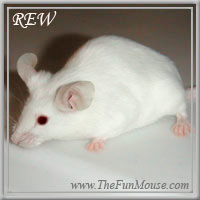 Ruby
RubyRuby eyes are dark red eyes that may be hard to distingush from normal black eyes in poor lighting. Ruby also dilutes the color of the coat a little.
Ruby eyes are relatively rare and may appear like dark eyes on darker-colored mice. White mice with ruby eyes are called ruby-eyed whites (REWs).
Ruby is recessive and occurs in genotype ru/ru, though there are other ways ruby eyes can form.
Not to confused with albinos (REWs are not pure albinos) and BEWs (BEWs have dark eyes, not ruby).
Markings


 Tan Belly / Tan
Tan Belly / TanTan gives mice a tan, golden, or brown belly.
Tan is recessive and occurs in genotype at/*. It originated from random mutation in commercial breeding.
A number of genes dilute tan into fox. Tan, despite being recessive, will always give the most a belly even if they have a dominant A allele like agouti or lethal yellow, unless they have a gene with overrides tan (like albino) or have a marking that covers up the belly.


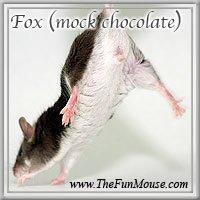 White Belly / Fox
White Belly / FoxFox gives mice a white belly.
Fox can occur in two different ways, either using white-bellied agouti (Aw/*) or diluting tan through a number of c-dilutes (normally chinchilla).


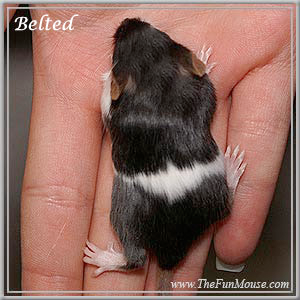 Belted
BeltedBelted mice have a "belt" of white going around their mid-section.
Belted is recessive and occurs in genotype bt/bt. It first originated as a result of random mutation.
Not to be confused with banded. Unlike banded mice, belted mice's marking starts at the back and is generally thicker on the back, thinning towards the belly.


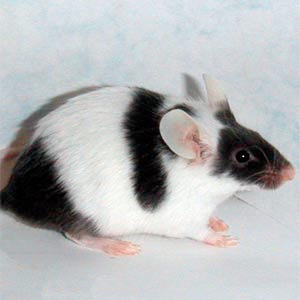 Banded
BandedBanded mice have a thick band of white going across their body. They can have up to two bands, referred to as double banded (normally occurs in homozygeous bandeds). The band(s) may also stop before going all the way around the mouse or be split (normally around the spine), referred to as broken banded.
Banded is dominant and occurs in genotype Wbd/* on chromosome 5. It first originated as a result of random mutation.
Not to be confused with belted. Unlike belted mice, banded mice's marking starts at the belly and is often so thick it can take up a majority of the mouse.

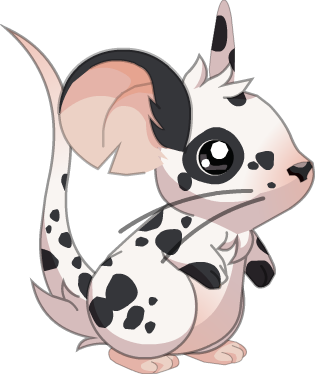
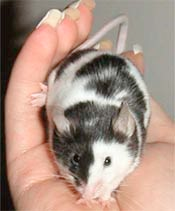 Piebald / Recessive Spotting / Cow Marked
Piebald / Recessive Spotting / Cow MarkedPiebald mice are normally mostly white with spots of color that may or may not be even. Type varies based on the specific pattern of these spots- broken refers to when these spots are asymmetrical, and even marked refers to when they are symmetrical.
Piebald is recessive and occurs in genotype s/s on chromosome 14. It first originated as a result of random mutation dating back to the 1920s.
Piebald can look a lot like banded, dutch, and other spotting genes dependent on the pattern of spots.


 Dutch
DutchDutch mice have a full-body white mark that makes them have colored oval-shaped spots around their eyes and a colored rump.
Dutch's genotype is unknown and many are unsure if a specific gene causes it or if it's a combination of spotting genes.


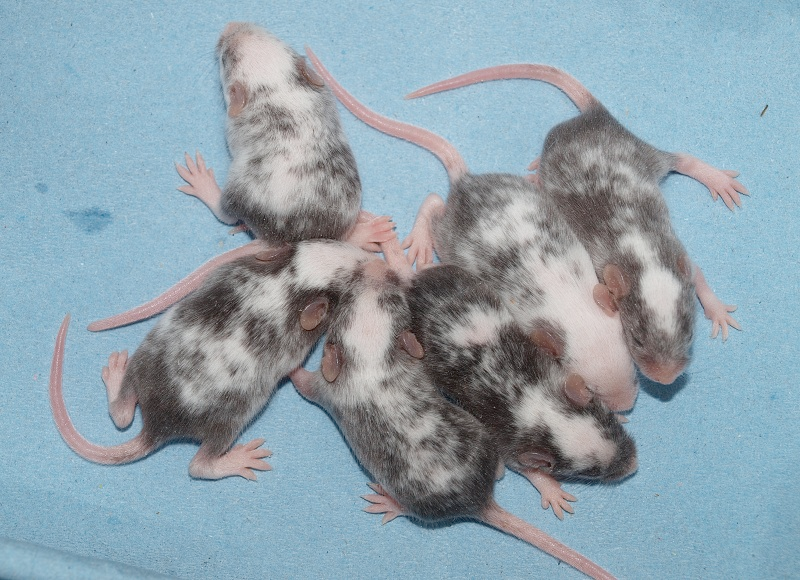 Variegated / Dominant Spotting
Variegated / Dominant SpottingVariegated mice may be mostly white with spots of color that normally aren't even. This gene is very easy to mix up with piebald.
Variegated is dominant and occurs in genotype W/w on chromosome 5. It first originated as a result of random mutation.
Variegated is lethal when homozygeous (W/W), and these babies get reabsorbed before birth.


 Rump White
Rump WhiteRump white mice have white rump.
Rump white is dominant and occurs in genotype Rw/* on chromosome 5. It first originated as a result of radiation-induced inversion mutation.
Rump white is lethal when homozygeous (Rw/Rw), and these babies get reabsorbed before birth.


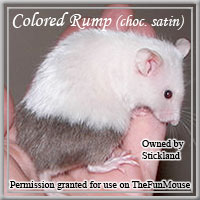 Colored Rump
Colored RumpColored rump mice have a white body and a rump of any other color.
Colored rump is presumably a specific distribution of white spots from spotting genes.


 Tricolor / Calico
Tricolor / CalicoTricolor mice have three visible colors, normally one of which is white. Most of the time, these colors will be a black or dark brown, a lighter brown, and white, creating a calico-like pattern, though tricolor can come in any color combination. Tricolors have patches of these colors.
Tricolor is presuambly a combination between splashed and a spotting gene.


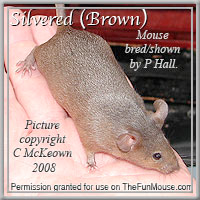 Silvered
SilveredSilvered mice have a mix of colorless and full color hairs, as well as silver-tipped hairs and striped hairs throughout the coat.
Silvered is recessive and occurs in genotype si/si on chromosome 10. It first originated as a result of random mutation in commercial breeding. Silvered can only occur in non-agouti (a/a) mice.
Though silvered is technically a color in its own right, the base color of the mouse can be any color at all.
Not to be confused with Roan, which lacks striped or tipped hairs.


 American Brindle / Viable Yellow
American Brindle / Viable YellowBrindle mice have tiger-like stripe patterns. American brindles have less-defined stripes towards the belly.
American brindle is dominant and occurs in genotype Avy/* on chromosome 2. It first originated as a result of random mutation.
Unlike English brindles, American brindle is not a sex-linked gene and mice with American brindle are prone to obesity, diabetes, allergies, and other health issues.
One popular variation of American brindle is snowtiger, where extreme dilution (ce/ce) or other c-dilute genes are combined with brindle to make white or off-white gray mice with coffee stripes. In the photo to the right, the rightmost mouse is a snowtiger.


 English Brindle / Sex-linked Brindle
English Brindle / Sex-linked BrindleBrindle mice have tiger-like stripe patterns. English brindles' stripes often widen as they age.
English brindle is dominant and occurs in genotype Mobr/* on the X chromosome. It first originated as a result of random mutation.
English brindle is a sex-linked gene. Homozygeous brindle (Mobr/Mobr) is lethal and males with English brindle will most likely die very young. English brindles lack the health issues of American brindles.
English brindle is non-agouti-dependent, so all mice with english brindle are non-agoutis (a/a).


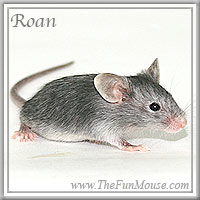 Roan / Roan Freckled
Roan / Roan FreckledRoan mice have a mix of white and colored hairs. Roan also tends to dilute the base color, and white hairs often bunch at the belly, creating a Fox-like effect.
Roan is dominant and occurs in genotype Rn/* or Rnfkl/* on chromosome 14. It first originated as a result of random mutation in laboratory mice.
Not to be confused with silvered. Roan lacks tipped and striped hairs (unless combined with other genes).
Roan is non-agouti-dependent, so all mice with roan are non-agoutis (a/a).


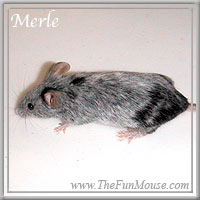 Merle
MerleMerle mice are marble-like in appearance, having a mix of white and colored hairs, but the white hairs don't occur in some locations, producing solid-color spots.
Merle is thought to be a modified version of roan or another gene which halts the roaning of some patches of fur.


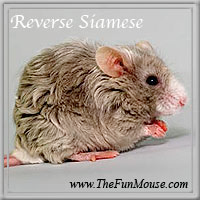 Reverse Siamese
Reverse SiameseReverse siamese mice have the inverse of the siamese pattern. Their points are lighter than their base color.
Reverse siamese's cause is unknown. Mice with this gene are normally (and perhaps always) coffee with white points.


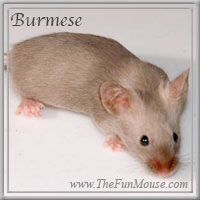 Burmese
BurmeseBurmese mice are a version of the siamese where the mouse's points are the same color as their base, only darker.
Burmese is a combination between chinchilla (cch) and siamese (ch).


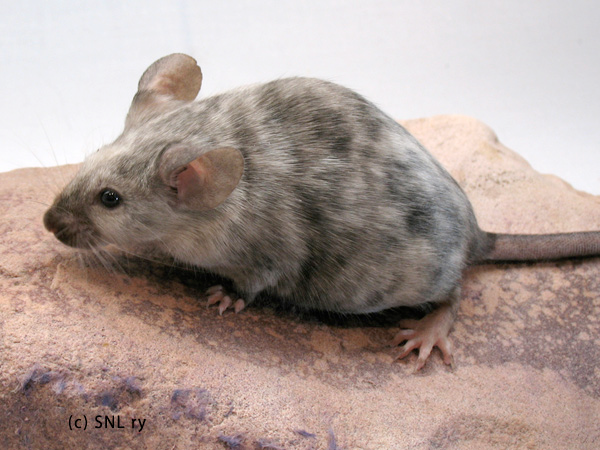 Splashed
SplashedSplashed mice have darker splashes of color on top of their base color.
Splashed's cause is unknown, but some speculate it's a dominant gene caused by genotype Spl/* on top of any c-dilute. Splashed, however, remains one of mouse breeding's most popular mysteries.
Not to be mistaken with variegated (white spots on color) and both brindles (different genotypes).
Body Types


 Fancy Type / Pet Type
Fancy Type / Pet TypeFancy type mice are the common body type of mice. They are smaller than show types, with smaller ears, thinner tails, and flatter backs. In the image to the right, the rightmost mouse is a fancy type.


 Show Type
Show TypeShow type mice have very large ears, arched backs, thick tails, broad faces, and tend to be larger than fancy type mice. In the image to the right, the leftmost mouse is a show type.


 Tailless / Brachyury / Short Tail
Tailless / Brachyury / Short TailTailless mice have either no tail or oddly short ones.
Many genes can cause tailless, but brachyury (T/*) is the most common, but normally only causes short tails. There is another gene that causes short tails and complete taillessness, a recessive one, but it's unknown beyond that and it being more common outside of America.


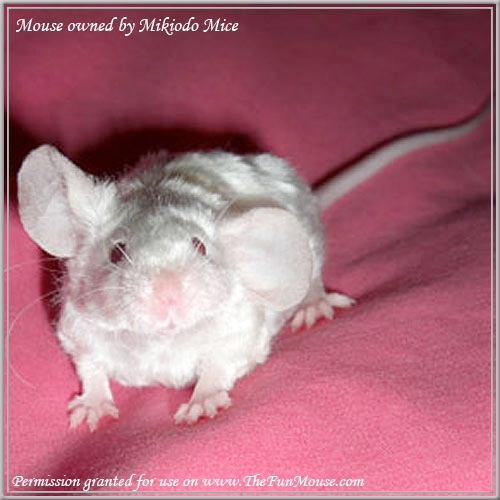 Gremlin
GremlinGremlin mice have very large, uneven ears. One ear is placed on the side of the head, while the other is placed normally.

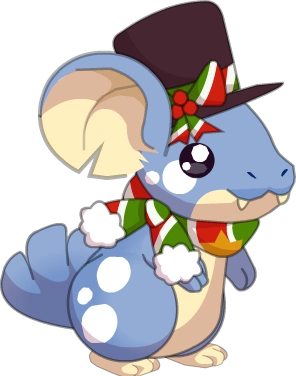
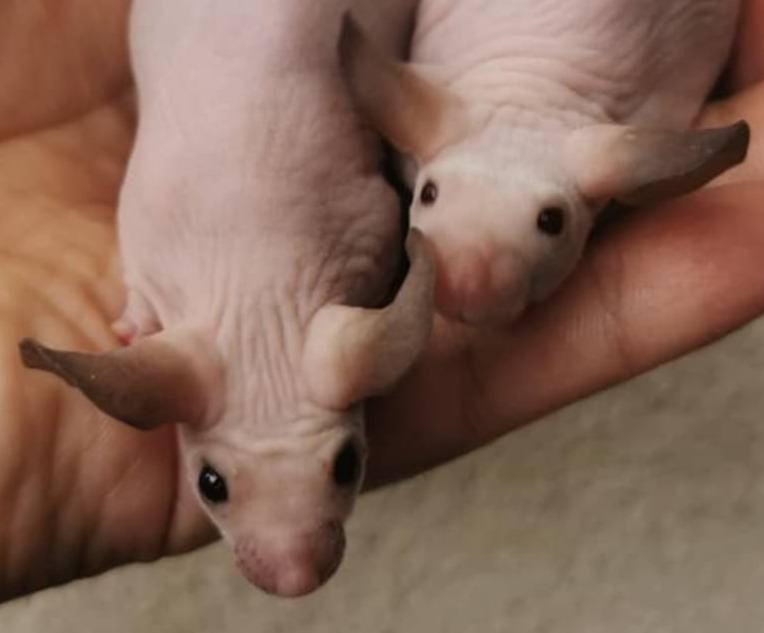 Snub Nose / Short Snout
Snub Nose / Short SnoutSnub nose mice are mice with very short snouts. It is recessive and occurs in genotype shsn. Short snout is considered a defect in show, and snub nose mice often have health issues like lower bone density, breathing problems, and smaller bodies.


